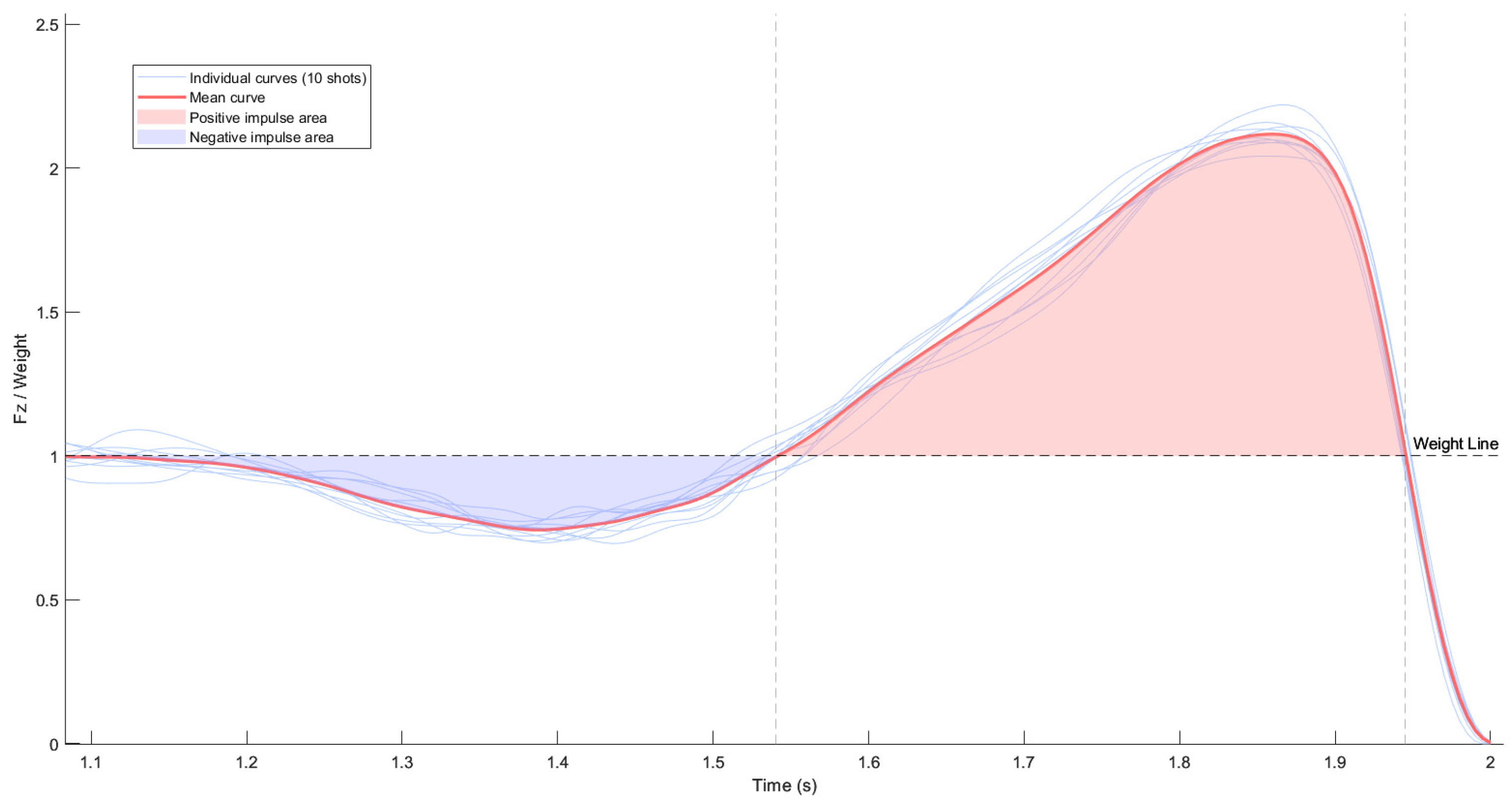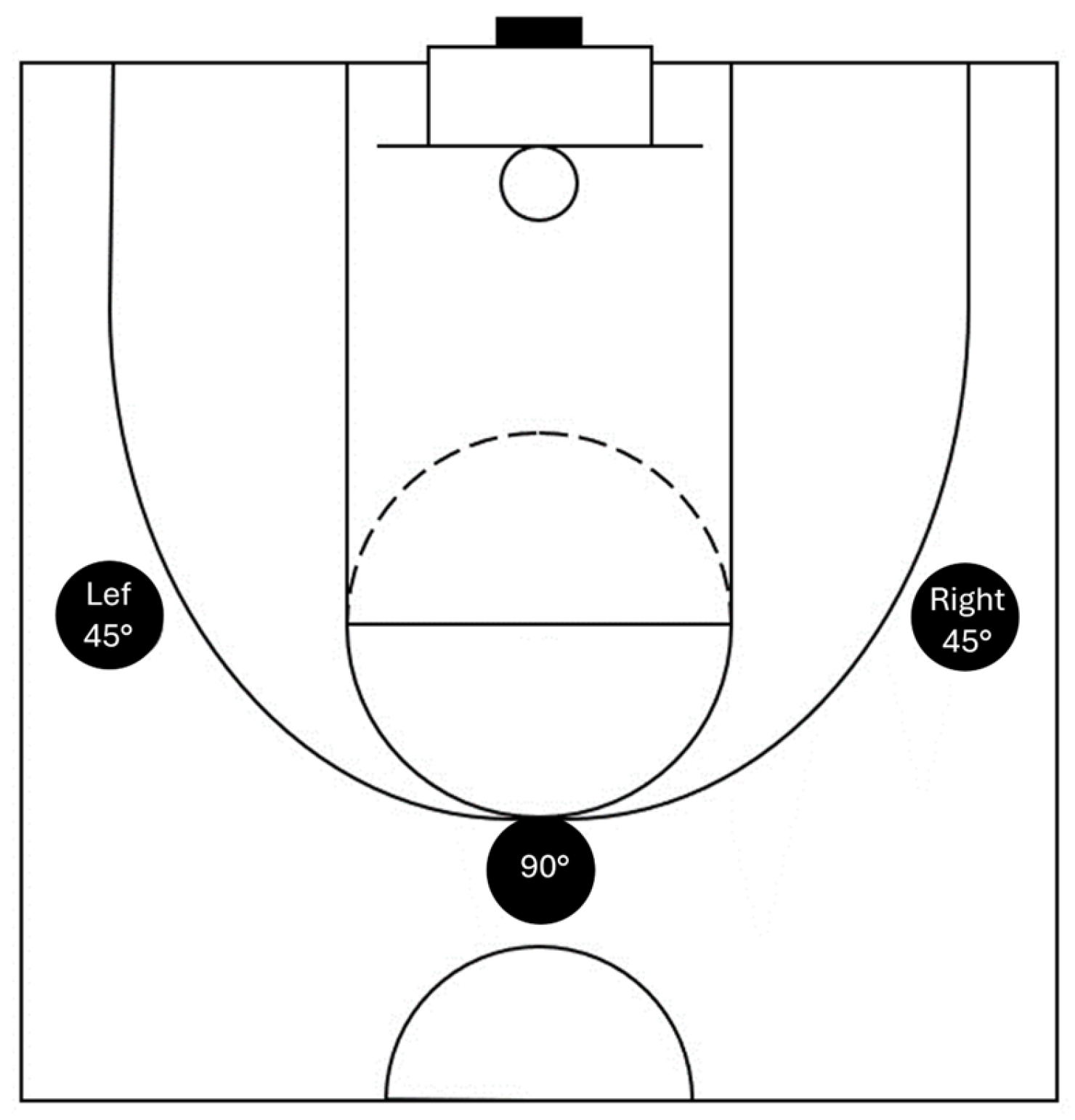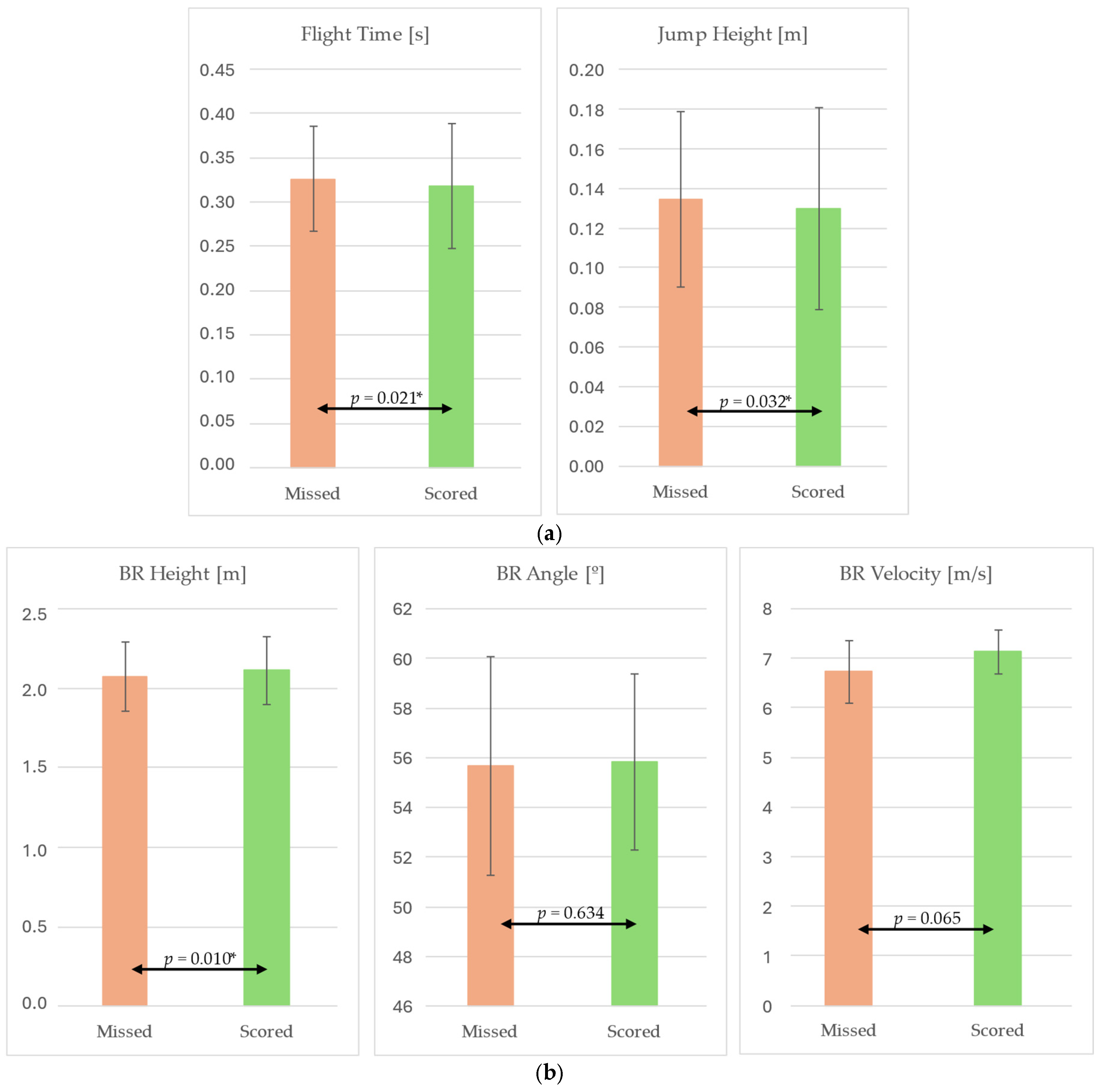Influence of Jump and Ball Release Parameters on Shooting Accuracy in Basketball Under Varying Constraints
Abstract
1. Introduction
2. Materials and Methods
2.1. Participants
2.2. Protocol
2.3. Equipment

2.4. Statistics Analysis
3. Results
4. Discussion
5. Conclusions
Author Contributions
Funding
Institutional Review Board Statement
Informed Consent Statement
Data Availability Statement
Acknowledgments
Conflicts of Interest
References
- Okazaki, V.H.A.; Rodacki, A.L.F.; Satern, M.N. A review on the basketball jump shot. Sports Biomech. 2015, 14, 190–205. [Google Scholar] [CrossRef]
- Erculj, F.; Supej, M. Impact of fatigue on the position of the release arm and shoulder girdle over a longer shooting distance for an elite basketball player. J. Strength Cond. Res. 2009, 23, 1029–1036. [Google Scholar] [CrossRef]
- Cao, S.; Geok, S.K.; Roslan, S.; Sun, H.; Lam, S.K. Mental fatigue and basketball performance: A systematic review. Front. Psychol. 2022, 12, 819081. [Google Scholar] [CrossRef]
- Oudejans, R.R.; Kuijpers, W.; Kooijman, C.C.; Bakker, F.C. Thoughts and attention of athletes under pressure: Skill-focus or performance worries? Anxiety Stress Coping 2011, 24, 59–73. [Google Scholar] [CrossRef]
- Crum, G. The Effect of Crowd Noise on Free Throws in Basketball. Senior Independent Study Theses. Paper 8686. The College of Wooster. 2019. Available online: https://openworks.wooster.edu/independentstudy/8686 (accessed on 18 July 2025).
- Cao, Z.; Price, J.; Stone, D.F. Performance Under Pressure in the NBA. J. Sports Econ. 2011, 12, 231–252. [Google Scholar] [CrossRef]
- Jones, G.; Hardy, L. Stress and Performance in Sport; John Wiley and Sons: Hoboken, NJ, USA, 1989. [Google Scholar]
- Baumeister, R.F. Choking under pressure: Self-consciousness and paradoxical effects of incentives on skillful performance. J. Personal. Soc. Psychol. 1984, 46, 610–620. [Google Scholar] [CrossRef]
- Vickers, J.N. Visual control when aiming at a far target. J. Exp. Psychol. Hum. Percept. Perform. 1996, 22, 342–354. [Google Scholar] [CrossRef]
- Zhu, Z.; Wu, H.; Li, L.; Jia, M.; Li, D. Effects of diverse resistance training modalities on performance measures in athletes: A network meta-analysis. Front. Physiol. 2024, 15, 1302610. [Google Scholar] [CrossRef]
- Agu-Udemba, C.C.; Cathey, A.C.; Palmer, T.B. Relationship between vertical jump height and muscle size and quality of the rectus femoris and vastus lateralis. Int. J. Exerc. Sci. Conf. Proc. 2018, 2, 4. [Google Scholar]
- Inaba, Y.; Hakamada, N.; Murata, M. Computation of Optimal Release Parameters of Jump Shots in Basketball. In Sport Science Research and Technology Support; Cabri, J., Pezarat-Correia, P., Vilas-Boas, J., Eds.; Springer: Cham, Switzerland, 2019; Volume 975. [Google Scholar]
- Karcher, C.; Buchheit, M. Shooting Performance and Fly Time in Highly Trained Wing Handball Players: Not Everything Is as It Seems. Int. J. Sports Physiol. Perform. 2017, 12, 322–328. [Google Scholar] [CrossRef]
- Radenković, M.; Lazić, A.; Stanković, D.; Cvetkovic, M.; Đorđić, V.; Petrovic, M.R.; Tomović, M.; Kouidi, E.; Preljević, A.; Marković, J.; et al. Effects of Combined Plyometric and Shooting Training on the Biomechanical Characteristics during the Made Jump Shot in Young Male Basketball Players. Int. J. Environ. Res. Public Health 2022, 20, 343. [Google Scholar] [CrossRef]
- van Maarseveen, M.J.; Oudejans, R.R. Motor and Gaze Behaviors of Youth Basketball Players Taking Contested and Uncontested Jump Shots. Front. Psychol. 2018, 9, 706. [Google Scholar] [CrossRef]
- Spina, M.; Cleary, T.; Hudson, J.L. An exploration of balance and skill in the jump shot. In Proceedings of the Archive of the 13 International Symposium on Biomechanics in Sports (1995), Thunder Bay, ON, Canada, 18–22 July 1995. [Google Scholar]
- Rojas, F.J.; Cepero, M.; Ona, A.; Gutiérrez, M. Kinematic adjustments in the basketball jump shot against an opponent. Ergonomics 2012, 43, 1651–1660. [Google Scholar] [CrossRef]
- Kambič, T.; Stepišnik Krašovec, F.; Erčulj, F.; Štirn, I. Biomechanical Adjustments of the Basketball Jump Shot Performed over Differently High Opponents. J. Hum. Kinet. 2022, 83, 23–28. [Google Scholar] [CrossRef]
- Csataljay, G.; James, N.; Hughes, M.; Dancs, H. Effects of defensive pressure on basketball shooting performance. Int. J. Perform. Anal. Sport 2013, 13, 594–601. [Google Scholar] [CrossRef]
- Okazaki, V.H.; Rodacki, A.L. Increased distance of shooting on basketball jump shot. J. Sports Sci. Med. 2012, 11, 231–237. [Google Scholar]
- Miller, S.; Bartlett, R. The relationship between basketball shooting kinematics and performance. J. Sports Sci. 1996, 14, 243–253. [Google Scholar] [CrossRef]
- Caseiro, A.; França, C.; Faro, A.; Branquinho Gomes, B. Kinematic analysis of the basketball jump shot with increasing shooting distance: Comparison between experienced and non-experienced players. Acta Bioeng. Biomech. 2023, 25, 61–67. [Google Scholar] [CrossRef]
- Cowin, J.; Nimphius, S.; Fell, J.; Culhane, P.; Schmidt, M. A Proposed Framework to Describe Movement Variability within Sporting Tasks: A Scoping Review. Sports Med. Open 2022, 8, 85. [Google Scholar] [CrossRef]
- Cabarkapa, D.; Cabarkapa, D.V.; Miller, J.D.; Templin, T.N.; Frazer, L.; Nicolella, D.P.; Fry, A.C. Biomechanical characteristics of proficient free-throw shooters—Markerless motion capture analysis. Front. Sports Act. Living 2023, 5, 1208915. [Google Scholar] [CrossRef]
- Ihalainen, S.; Kuitunen, S.; Mononen, K.; Linnamo, V. Determinants of elite-level air rifle shooting performance. Scand. J. Med. Sci. Sports 2016, 26, 266–274. [Google Scholar] [CrossRef]
- Browne, P.R.; Sweeting, A.J.; Woods, C.T.; Robertson, S. Methodological Considerations for Furthering the Understanding of Constraints in Applied Sports. Sports Med. Open 2021, 7, 22. [Google Scholar] [CrossRef]
- Giblin, G.; Tor, E.; Parrington, L. The impact of technology on elite sports performance. Sensoria 2016, 12, 3–9. [Google Scholar] [CrossRef]
- Russell, J.L.; McLean, B.D.; Impellizzeri, F.M.; Strack, D.S.; Coutts, A.J. Measuring Physical Demands in Basketball: An Explorative Systematic Review of Practices. Sports Med. 2021, 51, 81–112. [Google Scholar] [CrossRef]
- Preatoni, E.; Hamill, J.; Harrison, A.J.; Hayes, K.; Van Emmerik, R.E.; Wilson, C.; Rodano, R. Movement variability and skills monitoring in sports. Sports Biomech. 2013, 12, 69–92. [Google Scholar] [CrossRef] [PubMed]
- Amaro, C.M.; Gomes, B.B.; Mendes, R.; Castro, M.A. Effect of different height and distance oppositions on basketball shooting precision. J. Phys. Educ. Sport 2022, 22, 1271–1276. [Google Scholar]
- Kalipci, E.; Arslan, F. Determination of noise pollution knowledge in the sport centres of Konya city. J. Int. Environ. Appl. Sci. 2007, 2, 64–70. [Google Scholar]
- Biedert, R.; Buscher, G.; Dengel, A. The eye book. Inform. Spektrum 2009, 33, 272–281. [Google Scholar] [CrossRef]
- Ghasemi, A.; Zahediasl, S. Normality Tests for Statistical Analysis: A Guide for Non-Statisticians. Int. J. Endocrinol. Metab. 2012, 10, 486–489. [Google Scholar] [CrossRef]
- Batterham, A.M.; Hopkins, W.G. Making meaningful inferences about magnitudes. Int. J. Sports Physiol. Perform. 2006, 1, 50–57. [Google Scholar] [CrossRef]
- Joseph, J.; McIntyre, F.; Joyce, C.; Scanlan, A.; Cripps, A. A comparison of multidimensional qualities discriminant of selection in elite adolescent australian basketball athletes. PLoS ONE 2021, 16, e0256032. [Google Scholar] [CrossRef]
- Boddington, B.; Cripps, A.; Scanlan, A.; Spiteri, T. Operation of the basketball jump shooting accuracy test: Intra- and inter-rater reliability of scoring procedures and floor and ceiling effects for test performance. Int. J. Sports Sci. Coach. 2020, 15, 220–226. [Google Scholar] [CrossRef]
- Teramoto, M.; Cross, C. Importance of team height to winning games in the national basketball association. Int. J. Sports Sci. Coach. 2017, 13, 559–568. [Google Scholar] [CrossRef]
- Erčulj, F.; Supej, M. The impact of fatigue on jump shot height and accuracy over a longer shooting distance in basketball. Balt. J. Sport Health Sci. 2018, 4, 35–41. [Google Scholar] [CrossRef]




| Shooting Conditions | Mean ± SD | |||||
|---|---|---|---|---|---|---|
| Jump Height [m] | Flight Time [s] | BR Height [m] | BR Angle [°] | BR Velocity [m/s] | Accuracy [0; 4] | |
| Baseline Right | 0.25 ± 0.08 | 0.44 ± 0.07 | 2.13 ± 0.13 | 54.45 ± 3.23 | 6.99 ± 0.58 | 1.7 ± 1.4 |
| Baseline Middle | 0.23 ± 0.09 | 0.42 ± 0.08 | 2.09 ± 0.14 | 56.91 ± 2.48 | 6.78 ± 0.56 | 2.0 ± 1.5 |
| Baseline Left | 0.25 ± 0.09 | 0.44 ± 0.08 | 2.02 ± 0.20 | 57.47 ± 2.73 | 6.72 ± 0.63 | 1.7 ± 1.4 |
| Noise Right | 0.25 ± 0.08 | 0.44 ± 0.07 | 2.09 ± 0.20 | 54.79 ± 3.81 | 6.90 ± 0.70 | 1.7 ± 1.4 |
| Noise Middle | 0.24 ± 0.08 | 0.44 ± 0.08 | 2.11 ± 0.16 | 55.78 ± 2.84 | 6.79 ± 0.76 | 2.0 ± 1.5 |
| Noise Left | 0.25 ± 0.08 | 0.44 ± 0.07 | 2.07 ± 0.15 | 56.68 ± 3.31 | 6.80 ± 0.74 | 2.0 ± 1.5 |
| Opposition Right | 0.25 ± 0.08 | 0.43 ± 0.10 | 2.10 ± 0.15 | 55.17 ± 3.27 | 6.95 ± 0.73 | 1.6 ± 1.5 |
| Opposition Middle | 0.25 ± 0.09 | 0.44 ± 0.08 | 2.11 ± 0.14 | 55.40 ± 4.46 | 6.90 ± 0.74 | 1.7 ± 1.4 |
| Opposition Left | 0.25 ± 0.09 | 0.44 ± 0.08 | 2.10 ± 0.14 | 57.20 ± 2.46 | 6.85 ± 0.71 | 1.4 ± 1.3 |
| Effect | p, η2p | ||||
|---|---|---|---|---|---|
| Jump Height | Flight Time | BR Height | BR Angle | BR Velocity | |
| Position | 0.449, 0.002 | 0.171, 0.005 | 0.437, 0.002 | 0.510, 0.002 | 0.226, 0.004 |
| Noise | 0.092, 0.004 | 0.019 *, 0.008 | 0.344, 0.001 | 0.130, 0.003 | 0.159, 0.003 |
| Opposition | 0.606, 0.000 | 0.694, 0.000 | 0.826, 0.000 | 0.210, 0.002 | 0.953, 0.000 |
| Position × Noise | 0.814, 0.001 | 0.715, 0.001 | 0.929, 0.000 | 0.603, 0.001 | 0.194, 0.005 |
| Position × Opposition | 0.419, 0.002 | 0.368, 0.003 | 0.520, 0.002 | 0.823, 0.001 | 0.996, 0.000 |
| Variables | Correlation Analysis | |||
|---|---|---|---|---|
| Spearman (ρ) | Correlation | p | Tendency | |
| Flight Time-Accuracy | −0.081 | weak negative | 0.001 * | inverse (slightly) |
| Jump Height-Accuracy | −0.072 | weak negative | 0.005 * | inverse (slightly) |
| BR Height-Accuracy | 0.116 | weak positive | 0.002 * | direct (slightly) |
| BR Angle-Accuracy | 0.037 | - | 0.329 | - |
| BR Velocity-Accuracy | 0.084 | weak positive | 0.025 * | direct (slightly) |
Disclaimer/Publisher’s Note: The statements, opinions and data contained in all publications are solely those of the individual author(s) and contributor(s) and not of MDPI and/or the editor(s). MDPI and/or the editor(s) disclaim responsibility for any injury to people or property resulting from any ideas, methods, instructions or products referred to in the content. |
© 2025 by the authors. Licensee MDPI, Basel, Switzerland. This article is an open access article distributed under the terms and conditions of the Creative Commons Attribution (CC BY) license (https://creativecommons.org/licenses/by/4.0/).
Share and Cite
Amaro, C.M.; Castro, M.A.; Mendes, R.; Rice, H.; Gomes, B.B. Influence of Jump and Ball Release Parameters on Shooting Accuracy in Basketball Under Varying Constraints. J. Funct. Morphol. Kinesiol. 2025, 10, 459. https://doi.org/10.3390/jfmk10040459
Amaro CM, Castro MA, Mendes R, Rice H, Gomes BB. Influence of Jump and Ball Release Parameters on Shooting Accuracy in Basketball Under Varying Constraints. Journal of Functional Morphology and Kinesiology. 2025; 10(4):459. https://doi.org/10.3390/jfmk10040459
Chicago/Turabian StyleAmaro, Catarina M., Maria António Castro, Rui Mendes, Hannah Rice, and Beatriz B. Gomes. 2025. "Influence of Jump and Ball Release Parameters on Shooting Accuracy in Basketball Under Varying Constraints" Journal of Functional Morphology and Kinesiology 10, no. 4: 459. https://doi.org/10.3390/jfmk10040459
APA StyleAmaro, C. M., Castro, M. A., Mendes, R., Rice, H., & Gomes, B. B. (2025). Influence of Jump and Ball Release Parameters on Shooting Accuracy in Basketball Under Varying Constraints. Journal of Functional Morphology and Kinesiology, 10(4), 459. https://doi.org/10.3390/jfmk10040459








